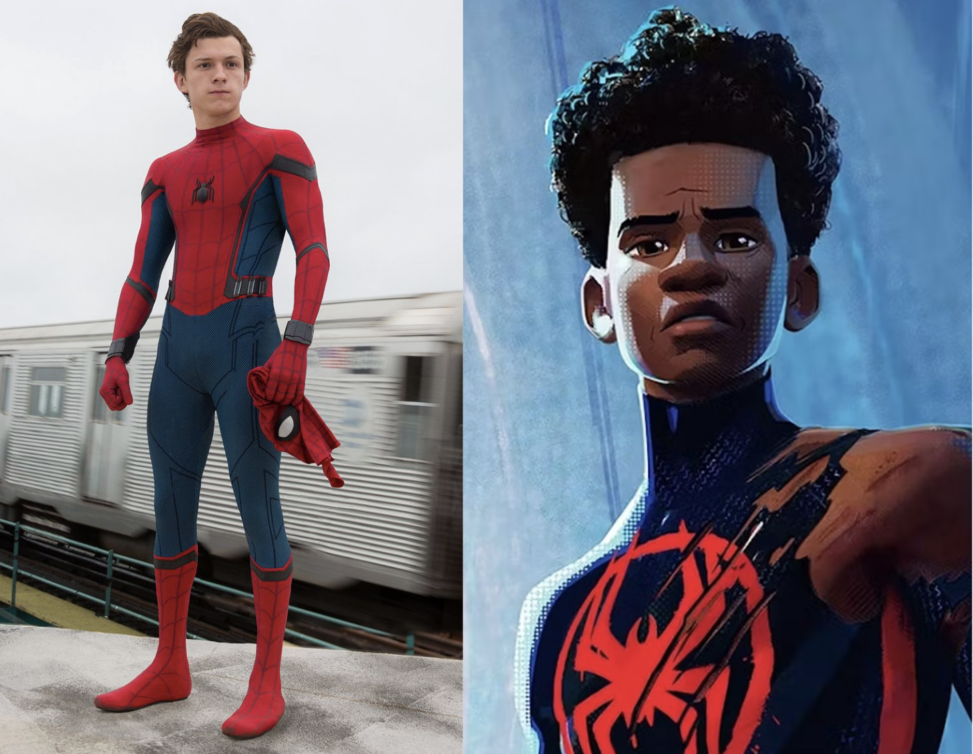Spider-Man has long symbolized the idea that ordinary people can become heroes. The original Peter Parker, created in 1962 by Stan Lee and Steve Ditko, represented the white, middle-class, American “Everyman”. When the Afro-Latino Miles Morales took up the mantle in Spider-Man: Into the Spider-Verse (2018), the character evolved from a symbol of universal whiteness into one of multicultural inclusivity.
Peter Parker’s Spider-Man signified a moral idea rooted in responsibility and personal sacrifice. His story, set in the whole middle-class neighborhoods of Queen, reflected postwar American values of self-reliance and duty. “Spider-Man represents an egalitarian view due to his belief that all people are equal and should be given equal access to opportunities.” In contrast, Miles Morales embodies a multicultural redefinition of that same hero. As an Afro-Latino Teenager raised in Brooklyn, Miles’s identity and environment are inseparable from his heroism. “Spider-Man: Into the Spider-Verse (2018) is a multiversal film which proves that anyone can become a hero despite any ethnic, gender or class concerns that people can have. It proves that Spider-Man is for anyone and can be changed to reflect different cultural values in order to further diverse voices and connect with a greater audience.” Where the mask ceases to hide identity and instead becomes a celebration of cultural multiplicity. Thus, Spider-Man evolves from a symbol of individual morality into a mirror of collective diversity.
Peter Parker is traditionally portrayed as intelligent, hardworking, and morally upright; a young man balancing personal struggle and protecting the city. By contrast, Miles Morales is youthful, artistic, bilingual, and emotionally expressive. His attributes: graffiti art, love for hip-hop, and respect for family; reflect a contemporary, community-centered identity. Kristen Warner (2015) explains that such portrayals challenge Hollywood’s “colorblind” casting, acknowledging that race and culture are integral, not incidental, to character development. So, Miles’s traits change what it means to be a hero from being alone and tough to working together, valuing differences, and being mentally strong.
Miles Morales’s story intentionally subverts racial and generational stereotypes. In earlier superhero narratives, Black and Latino characters often appeared as sidekicks or comic relief. Into the Spider-Verse dismantles that by placing Miles at the narrative’s center and surrounding him with mentors of diverse backgrounds. The movie combines graffiti, hip-hop, and comic book styles to create a visual aesthetic that connects heroism with urban creation rather than urban demise. His camouflage power symbolizes social invisibility, while his venom blasts embody empowerment and voice. These new abilities create a transition from invisibility to visibility. In contrast to Peter’s focus on restraint and moral burden, Miles’s power celebrates agency, visibility, and cultural pride. Spider-Man goes from being a white universal figure to a hero of many kinds when he breaks away from stereotypes.
The cultural impact of Miles Morales extends beyond the screen, for many young viewers, particularly black and Latino audiences, Miles’s story affirms that they too can embody heroism. As Schiappa, Gregg, and Hewes (2005) argue in their “parasocial contact hypothesis,” exposure to positive, diverse media characters can reduce prejudice and foster empathy in audiences. Miles’s character thus sets new expectations for ordinary people: that heroism is not bound to race conformity but grounded in empathy, creativity, and collaboration. His story makes people think they can do good things no matter what their past is.
The effects of this representation shift are largely enhancing. Studies of audience identification show that diverse heroes improve self-esteem and belonging among marginalized viewers (Lu, Green, and Alon 2024). Miles’s portrayal enables viewers of color to feel visible within genres that once excluded them. It also broadens white viewers’ empathy by normalizing racial difference within a beloved cultural icon. However, this transformation has not been universally accepted. Some fans reacted negatively to Miles, viewing him as a “replacement” for Peter Parker. This backlash reveals the fragility of whiteness as the default identity in mainstream culture (DiAngelo 2011). Still, the overall psychological effect is progressive: expanding the emotional and imaginative range of who can be seen as a hero.
From Marvel’s Black Panther to DC’s Batwoman, the rise of Miles Morales is in line with larger social moves toward inclusion in entertainment. His success signals a generational shift toward diversity as a cultural norm. But, as with most progressive changes, it was met with opposition from people who didn’t want to see racial categories changed. Nevertheless, the film’s critical and commercial success demonstrates a societal readiness for diverse heroes and the erosion of stereotypes that once constrained them.
Across race, age, ability, and gender expression, the evolution from Peter Parker to Miles Morales redefines what Spider-Man, and by extension, heroism, signifies. Peter’s heroism was solitary and universalized through whiteness; Miles’s is communal and specific, grounded in multicultural identity. This transition not only challenges old stereotypes but also reshapes audience expectations and psychological identification. Into the Spider-Verse proclaims, “Anyone can wear the mask”. That statement, once metaphorical, now represents a genuine social shift: from invisibility to visibility, from exclusion to belonging.


Senna Rock
Alejandra has done a quality job at presenting the comparison between the characters, Peter Parker and Miles Morales. They describe the change in how Spider-Man started off as a symbol of a white, middle-class American and then developed into a character that represented multicultural inclusivity. The analysis was successful in that it highlighted the comparison between the two characters, while providing scholarly sources to strengthen their argument. In contrast, though, I felt the analysis was written more as a summary of who the characters are rather than analysing the transformation from one character to the other. The first piece of feedback I would give is to focus your analysis more on how the visual aspects shape and contribute to the transformation of the two versions of Spider-Man. This helps the reader understand the two versions of the character more clearly. The two images they chose to use illustrated the visual comparison of the characters discussed. Also, as the reader, it helped me visualize what I was reading, which I found helpful. After reading this analysis, I now have an understanding of how Peter Parker was shaped as a white hero, which then evolved into Miles Morales representing a modern version of Spider-Man that was multicultural and creative. Overall, Alejandra has presented a well-constructed analysis regarding the comparison of the original Peter Parker and Miles Morales. They have showcased the different traits of each character and connected it back to how these differences are ultimately a reflection of modern-day culture. A stronger focus on the visual elements in terms of the characters in action would strengthen your analysis, but overall, this was a well-articulated piece.
– Senna Rock